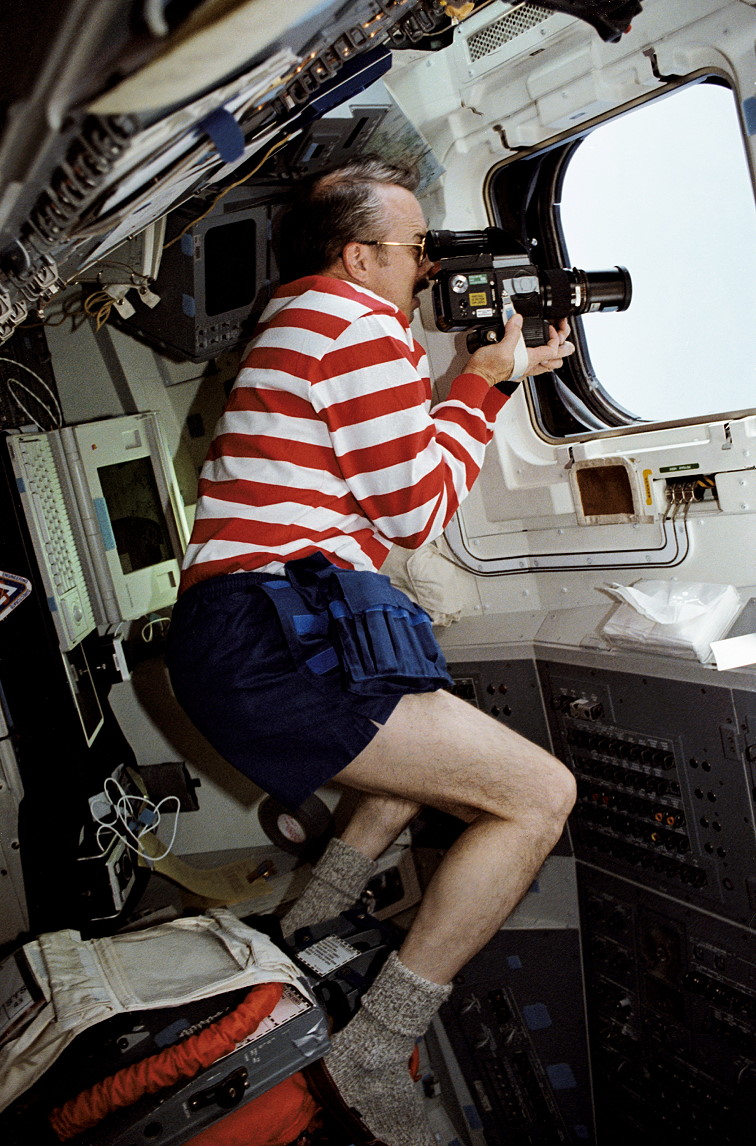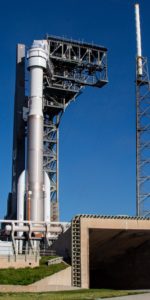
Thirty years ago today, Space Shuttle Atlantis flew a mission which harked back to the past and set in place a cornerstone to enable the exploration of the future. On the morning of 2 August 1991, the crew of STS-43—Commander John Blaha, Pilot Mike Baker and Mission Specialists Shannon Lucid, Jim Adamson, and David Low—rocketed into space to launch NASA’s fourth Tracking and Data Relay Satellite (TDRS). Part of a network of geostationary-orbiting communications and relay platforms for the shuttle and the space agency’s major scientific assets, TDRS was joined aboard Atlantis by a menagerie of research and technology investigations, many of which would evolve into systems for today’s International Space Station (ISS).
For Blaha, it was his third shuttle mission. In his NASA oral history, he recalled a conviction that every person who came back from space was psychologically “changed” in some way and became a “different” human being. When he returned from STS-33 in November 1989, he was finishing up his medical debriefing with a flight surgeon, when he asked an odd question. “Who else gives a debrief like me?”
The flight surgeon replied that Shannon Lucid offered a similar insight after her missions. As circumstances transpired, the pair would fly two shuttle flights together and would meet in space a third time in September 1996, as Lucid wrapped up a six-month stay aboard Russia’s Mir space station and Blaha arrived for his own four-month stay.

The STS-43 crew was announced by NASA in May 1990. Theirs was to be a five-day mission, originally targeted for May 1991 aboard shuttle Discovery, to deploy TDRS-E atop a Boeing-built Inertial Upper Stage (IUS) booster. A jubilant Blaha went directly to Lucid’s office with a request: after a day or two in orbit, they would exchange views on how each of them had “changed” whilst away from Earth.
But in his oral history, Blaha added another aspect of his command style. He knew that his crew were all “sharp people” and he felt no need to micromanage them or look over their shoulders. “Look, I don’t care how many mistakes you make during training,” he told them. “You can talk and ask all the questions you want in the debriefs. I’m not worried about us looking bad in training. I just want you to be ready when we launch.”

That readiness was tried and tested over the course of the following year, as the post-Challenger shuttle program fell foul to a summer of hydrogen leaks in 1990. Original plans, baselined in NASA’s February 1991 shuttle manifest, called for Discovery to fly the STS-39 mission for the Department of Defense in March, then Blaha’s STS-43 in July, and subsequently STS-48—tasked to deploy the Upper Atmosphere Research Satellite (UARS)—during a critical “science window” around November. However, STS-39 was postponed several weeks and, keen to preserve the UARS window, NASA decided in March to shift STS-43 onto Discovery’s sister, Atlantis.
Having returned from the STS-37 flight in the second week of April, Atlantis immediately underwent processing to ready her for her next mission. She spent nine weeks in the Orbiter Processing Facility (OPF) at the Kennedy Space Center (KSC), before rolling into the Vehicle Assembly Building (VAB) for stacking onto her External Tank (ET) and twin Solid Rocket Boosters (SRBs).

The complete STS-43 stack was transferred to Pad 39A on 25 June, with launch targeted for 23 July. At just 103 days from landing to launch, it was the shortest turnaround by any member of NASA’s shuttle fleet in the post-Challenger era.
Launch on the 23rd was routinely postponed by 24 hours, when a faulty controller on one of Atlantis’ three Space Shuttle Main Engines (SSMEs) needed replacement. A second attempt on 1 August was held at T-9 minutes when a vent valve failed to produce a closed indication after cabin leak checks had concluded.

As circumstances transpired, the valve had closed correctly—and the error was nothing more than an instrumentation glitch—but at this stage the weather closed in and launch was scrubbed. Finally, on the morning of the 2nd, Blaha and his crew were awakened in their quarters in the Operations & Checkout (O&C) Building. They departed for the pad at around 7:50 a.m. EDT, tracking a late-morning liftoff.
“At this time in the count, you really start putting your thinking hat on,” Blaha recalled, “’cause you gotta go to work.” Without further ado, Atlantis roared into a clear Florida sky at 11:02 a.m. Ascent proved nominal, with four members of the crew having flown before and Baker as the only “rookie.” In his post-landing remarks, he commented that the ride on the SRBs was “a little bit rough”, but that it smoothed out dramatically when the boosters were jettisoned, a little of two minutes into the flight. “It makes your front windows go opaque,” added Blaha of this highly dynamic period of ascent.

Preparations to deploy TDRS-E got underway almost immediately after reaching orbit, with the release of the payload scheduled six hours into the mission. By this stage, STS-43 had been extended to nine days in length, in order to support a wide range of biomedical and scientific experiments.
Three previous TDRS satellites had been deployed—the first aboard STS-6 in April 1983 and two more in the post-51L era, with TDRS-B lost aboard Challenger’s ill-fated final flight—and with TDRS-E a key position would be filled in geosynchronous orbit at 174 degrees West longitude.

Like its predecessors, TDRS-E was mounted atop Boeing’s IUS booster and the complex was accommodated within a donut-shaped Airborne Support Equipment (ASE) ring at the rear of Atlantis’ payload bay. It filled two-thirds of the 60-foot-long (15-meter) bay. The ASE acted as a “tilt-table” and was employed to raise the TDRS-IUS stack firstly to an angle of 29 degrees, where telemetry and other checks were performed and the booster was transferred to its on-board batteries, and finally to the deployment angle of 58 degrees.
During deployment, Lucid and Adamson oversaw the checkout of IUS systems, whilst Baker kept Atlantis in the proper attitude and Low handled the cameras for video and still imagery. And, according to Lucid, Blaha kept hold of the flight plan and timeline, “just to make sure the rest of us were all doing our jobs”. At 29 degrees, the IUS systems were transferred to internal batteries, ahead of raising the stack to 58 degrees, whereupon the booster’s ordnance—fitted with compressed springs—physically ejected the payload at a rate of 12 cm (4.7 in) per second.

Deployment occurred six hours into the mission and the huge stack surprised Lucid as it swept silently over Atlantis’ crew cabin and into the blackness. Twenty minutes later, Blaha executed a burn of the shuttle’s Orbital Maneuvering System (OMS) engines to create a safe separation distance, prior to the ignition of the IUS motor. Over the next few days, the newly renumbered “TDRS-5” was brought to fully-functional status and prepared for several weeks of rigorous testing. By early October 1991, it was declared operational in its prime orbital “slot” of 175 degrees West longitude.
With TDRS gone, the astronauts of STS-43 could turn their attention to a week of experiments in the shuttle’s middeck and payload bay. The scientific focus of the mission—which had already resulted in an extension of the mission from five to nine days—had also been manifested in the shape of the crew patch, which resembled an Erlenmeyer lab flask. Interestingly, the flat base, conical-bodied and cylindrical-necked nature of this flask also bore a close resemblance to the Mercury capsule, which had lofted America’s first astronaut Al Shepard into space three decades earlier in May 1961.

In Atlantis’ cabin, investigations into protein crystal growth, the processing of polymer membranes, combustion science studies and liquid-to-liquid diffusion were undertaken, as were observations of terrestrial aurorae and measurements of the effect of acceleration on delicate experiments.
Feasibility experiments were carried out to evaluate fiber-optic technology for video and audio communications between the payload bay and the crew cabin. And in the payload bay was the Shuttle Solar Backscatter Ultraviolet (SSBUV) instrument to calibrate the measurements taken by a fleet of ozone-monitoring satellites.

Flying a matter of months after Iraqi dictator Saddam Hussein’s retreating troops ignited oilfields in Kuwait, the effects upon Earth’s atmosphere were profound. “The planet’s beautiful,” recalled Blaha after the flight, but when they flew over the Middle East and beheld the palls of smoke, “boy, it looked like the planet was out of focus”.
This environmental tragedy was juxtaposed by the power and beauty of the rest of the Home Planet. The astronauts flew right over the eye of Hurricane Fefa in the Pacific Ocean and on one occasion Blaha floated up to the shuttle’s flight deck one morning, eating breakfast and watching his home world drift past him. “What a lucky person I am,” he wistfuly remarked later, “to be able to see this scene.”

Atlantis broke new ground at the end of her STS-43 mission, by becoming the first post-Challenger flight in which the Shuttle Landing Facility (SLF) at the Kennedy Space Center (KSC) in Florida was scheduled as her primary landing site. With the successful returns of STS-38 in November 1990 and STS-39 in May 1991, NASA’s improved sense of confidence prompted the agency to place Edwards Air Force Base in California on “reserve” status for the first time in five years.
Landing in Florida eliminated the $1 million cost and the additional week of processing time needed to fly the orbiter across the continent from California and was seen by NASA as a key step in moving from the post-Challenger mindset of excessive conservatism to one of full shuttle operations.

In the early summer of 1991, the decision by NASA Associate Administrator for the Office of Space Flight Bill Lenoir to resume KSC landings aroused criticism, with many engineers and managers arguing that shuttles should land at Edwards until “tougher tires” had been fitted and tested.
The damage to STS-39’s tires after touching down in a crosswind raised further concern. Even Space Shuttle Program Manager Bob Crippen insisted that KSC landings would only be approved if strict rules were met. In the weeks before STS-43, it seemed likely that Atlantis would be directed instead to Edwards.

But conditions in Florida were perfect and on 11 August Blaha and Baker guided their ship smoothly onto Runway 15, touching down at 8:23 a.m. EDT. And in keeping with his character, Blaha descended the steps last, ensuring that he shook hands with each of his crewmates as they disembarked from Atlantis.
The next mission, STS-48 in September, would go a step further by attempting to land at KSC in darkness, but Crippen remained cautious. “We’re still going to land at Edwards,” he told journalists. “The weather is going to end up dictating that. I’m budgeting for about 60 percent of the flights landing at Edwards and 40 percent at KSC.” By the end of the Shuttle era, in July 2011, Crippen’s 60-40 prediction had proven accurate, but fell in favour of KSC. Of the 133 shuttle missions which successfully landed, a total of 78 touched down in Florida, 54 at Edwards, and a single flight at White Sands in New Mexico.






One Comment
One Ping
Pingback:What a Lucky Person: Remembering STS-43, Thirty Years On